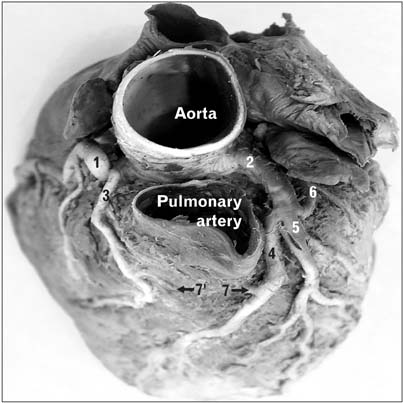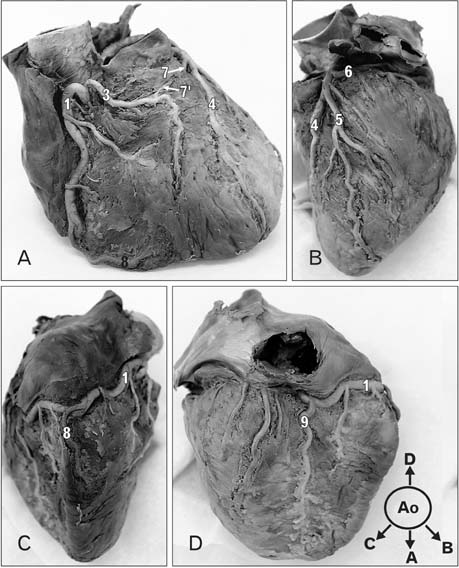Anat Cell Biol.
2015 Jun;48(2):144-146. 10.5115/acb.2015.48.2.144.
Dual left anterior interventricular coronary artery with a rare course in a Korean
- Affiliations
-
- 1Medical Course, Jeju National University School of Medicine, Jeju, Korea.
- 2Department of Anatomy, Jeju National University School of Medicine, Jeju, Korea. spyoon@jejunu.ac.kr
- 3Institute of Medical Science, Jeju National University, Jeju, Korea.
- KMID: 1845283
- DOI: http://doi.org/10.5115/acb.2015.48.2.144
Abstract
- Dual left anterior interventricular coronary artery (also called left anterior descending artery, hereafter referred as LAD) is a rare congenital coronary artery anomaly. Notably, type IV dual LAD has never been reported in Koreans. During a routine dissection, a new variant of type IV dual LAD was found in a 57-year-old Korean male cadaver, whose cause of death was unknown. One LAD originated from the right coronary artery, coursed through the anterior interventricular sulcus, but did not reach the apex cordis. The other LAD arose from the left coronary artery, never entered the anterior interventricular sulcus through its course, but reached the apex cordis, where it met the posterior interventricular branch of the right coronary artery. This is the first report on a new variant of type IV dual LAD in Koreans, which is of clinical importance during procedures containing the coronary artery.
MeSH Terms
Figure
Cited by 1 articles
-
Anatomy of the septal perforating arteries of the heart
Sung Deuk Kim
Anat Cell Biol. 2019;52(3):236-241. doi: 10.5115/acb.18.175.
Reference
-
1. Spindola-Franco H, Grose R, Solomon N. Dual left anterior descending coronary artery: angiographic description of important variants and surgical implications. Am Heart J. 1983; 105:445–455.2. Maroney J, Klein LW. Report of a new anomaly of the left anterior descending artery: type VI dual LAD. Catheter Cardiovasc Interv. 2012; 80:626–629.3. Tuncer C, Batyraliev T, Yilmaz R, Gokce M, Eryonucu B, Koroglu S. Origin and distribution anomalies of the left anterior descending artery in 70,850 adult patients: multicenter data collection. Catheter Cardiovasc Interv. 2006; 68:574–585.4. Bae YJ, Cha KS, Park JG, Jang CR, Lee HS, Kim MH, Kim YD, Kim JS. Dual left anterior descending coronary artery: incidence, angiographic features and clinical significance in the era of revascularization. Korean Circ J. 2000; 30:1092–1098.5. Andreou AY, Avraamides PC. Short branch of type IV dual left anterior descending coronary artery running as an aberrant obtuse marginal branch: a previously undescribed arrangement. Clin Anat. 2009; 22:873–875.6. Bhatia V, Arora P, Pandey AK, Kaul U. Type IV dual left anterior descending coronary artery: a rare anomaly. Heart Views. 2010; 11:64–66.7. Stougiannos P, Tousoulis D, Trikas A, Stefanadis C. Anomalous origin and course of a dual left anterior descending coronary artery. Int J Cardiol. 2011; 146:e53–e55.8. Andreou AY. The parallel left anterior descending coronary artery. Int J Cardiol. 2010; 138:219–220.9. Lee Y, Lim YH, Shin J, Kim KS. A case report of type VI dual left anterior descending coronary artery anomaly presenting with non-ST-segment elevation myocardial infarction. BMC Cardiovasc Disord. 2012; 12:101.10. Burton RA, Quinn TA, Kohl P. Rediscovering the third coronary artery. Eur Heart J. 2011; 32:1435–1437.11. Murphy E. Cardiology review. 2nd ed. Philadelphia: WB Saunders Co.;2000. p. 871–875.12. Ogden JA. Congenital anomalies of the coronary arteries. Am J Cardiol. 1970; 25:474–479.13. Houyel L, Bajolle F, Capderou A, Laux D, Parisot P, Bonnet D. The pattern of the coronary arterial orifices in hearts with congenital malformations of the outflow tracts: a marker of rotation of the outflow tract during cardiac development? J Anat. 2013; 222:349–357.14. Li J, Soukias ND, Carvalho JS, Ho SY. Coronary arterial anatomy in tetralogy of Fallot: morphological and clinical correlations. Heart. 1998; 80:174–183.15. Chiu IS, Wu CS, Wang JK, Wu MH, Chu SH, Hung CR, Lue HC. Influence of aortopulmonary rotation on the anomalous coronary artery pattern in tetralogy of fallot. Am J Cardiol. 2000; 85:780–784.
- Full Text Links
- Actions
-
Cited
- CITED
-
- Close
- Share
- Similar articles
-
- 2 Cases of Dual Left Anterior Descending Coronary Artery
- Type 4 Dual Left Anterior Descending Artery: A Case Report of a Rare Congenital Coronary Anomaly
- Independent origin of anterior interventricular and left marginal arteries from the left posterior aortic sinus
- Anomalous Origin of the Right Coronary Artery from the Left Anterior Descending Artery: An Extremely Rare Variety of Single Coronary Artery
- Anatomy of the septal perforating arteries of the heart



